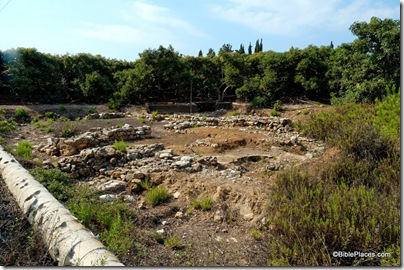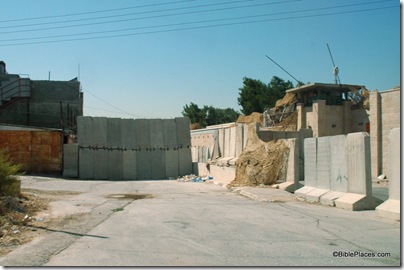You know that the year is drawing to a close when you see calendars for 2010 on store racks. I just received yesterday the 2010 Holy Land Calendar produced by Lamb and Lion Ministries, which exclusively features photographs from BiblePlaces.com. The calendar notes all the major American holidays, and its inclusion of the Jewish holy days makes it a great way to keep track of important events not on many American calendars. You can purchase this beautiful calendar online, and if you order 10 (for Christmas gifts), they will give you two for free.
From a press release from the University of Haifa:
The remains of a Minoan-style wall painting, characterized by a blue background, the first of its kind to be found in Israel, was discovered in the course of the recent excavation season at Tel Kabri. This fresco joins others of Aegean style that have been uncovered during earlier seasons at the Canaanite palace in Kabri. “It was, without doubt, a conscious decision made by the city’s rulers who wished to associate with Mediterranean culture and not adopt Syrian and Mesopotamian styles of art like other cities in Canaan did. The Canaanites were living in the Levant and wanted to feel European,” explains Dr. Assaf Yasur-Landau of the University of Haifa, who directed the excavations.
The remains of a Canaanite city from the Middle Bronze Age (2000-1550 B.C.) have been exposed at Tel Kabri, next to Kibbutz Kabri near Nahariya. A palace for the city’s rulers stands in the center of the city, which was the most important of the cities in the Western Galilee during that period. Excavations began at Tel Kabri in 1986, conducted by the late Prof. Aharon Kempinski, and were halted in 1993. Over the past years, excavations have been renewed by teams directed by Dr. Yasur-Landau of the Leon Recanati Institute for Maritime Studies at the University of Haifa and Prof. Eric Cline of The George Washington University. Tel Kabri is unique in that after the city was deserted, no other city was built over its remains. Therefore, this is the only Canaanite city that can be excavated in its entirety. The palace too, which has been measured with geophysical tools at 1 to 1.5 acres, is the only such palace of this period that can be excavated fully. “The city’s preservation enables us to get a complete picture of political and social life in the Canaanite period. We can reveal whether or not it had a central government, whether taxes were levied, what sort of agriculture there was and how politics were conducted at the time,” Dr. Yasur-Landau explains.
The full press release is here, and an Arutz-7 story is here. If you’ve been to Crete, you may be a bit disappointed with the photos.
HT: Joe Lauer
Tell Kabri, Middle Bronze palace, October 2005
- Tagged Discoveries, Excavations
Hundreds of Crusader-era marble pieces were discovered in Acco recently. You can read the press release, the JPost report or the Arutz-7 account, story here, or download high-res photos here.
The house in Luxor of Howard Carter, the man who discovered the tomb of King Tutankhamen, has been opened as a museum.
The NY Times has an interesting and humorous article on Raphael Golb, arrested for impersonation and identity theft in an attempt to stem the tide that rejected his father’s conclusions about the Dead Sea Scrolls. Golb is delighted that the articles he wrote under the name of “Charles Gadda” have been read by so many. I wonder how happy he is that so many are reading about his desperate attempts to stay out of jail.
BibleWorks has a sale for new customers now, offering $30 off the purchase of BibleWorks 8 and one module. For more, see here.
Logos Bible Software released a major new version this week. So far, everything I’ve heard is
positive. I don’t use anything with an “i” in it, but if I did, I’d be real happy about the ability to have my entire library on my phone at no extra cost.
- Tagged Discoveries, Egypt, Resources
A new exhibit opens on November 11 at the Davidson Center south of the Temple Mount in Jerusalem. From Arutz-7:
Among the artifacts to be displayed next week is a rare collection of 2,000-year-old coins that were burnt during the Great Revolt by the Jews against the Roman occupation, in which the Second Holy Temple was destroyed. The Western Wall, which was outside the Temple and not a part of it, is the only remaining part of the immediate area that remained standing following the destruction. The collection includes unique coins that were minted in Jerusalem during the Second Temple period. One extraordinary find to be presented to the public for the first time is an extremely rare shekel that was minted by the Jewish rebels during the last months of the revolt, in the year 70 CE. Also on display will be other coins that were found in different excavations in the region and have a wide geographic origin, from Persia, via North Africa and as far away as France. These coins attest to the centrality of Jerusalem for all of the people who visited the city thousands of years ago, while leaving behind a "souvenir" in the area. It is interesting to note the difference between the Jewish coins and others on display. Contrary to pagan coins, the ruler was not usually depicted on coins of Jewish origin, due to the Jewish prohibition against making a "graven image" or idol. According to an IAA statement, it is for this reason that a variety of symbols of inanimate objects, such as a wreath or scepter and helmet, appear on many Jewish coins.
The Arutz-7 article also notes that the sarcophagus lid with the inscription “son of the high priest” will be on display. The article has several beautiful photos of coins.
- Tagged Jerusalem, New Exhibits, Temple Mount
Foundation Stone has a fascinating interview with Zachi Zweig, who co-leads the Temple Mount Sifting Project with Gabriel Barkay. It was Zweig who brought public attention to the Muslim dumping of the Temple Mount material many years ago, and his initiative led Barkay to secure a permit for the project. Barkay was interviewed recently about the project, and now Zweig provides more detail about some of the latest discoveries.
You can listen to the 45-minute interview (here, select part 2), but here are a few of the highlights:
- They have been working 6 days a week for about 5 years now, but they have sifted only 20% of the material. They estimate 15 more years of work!
- Their interest is in knowledge, in understanding the ancient world. This is sharply contrasted with the Arabs who removed this ancient material from the Temple Mount and dumped it in the Kidron Valley.
- There are some tunnels and hollow spaces under the Temple Mount that have not been previously known, including one with an Aramaic inscription.
- There is a mikveh on the Temple Mount, found in the 1930s but not accurately identified until recently.
- Recently the Franciscans were digging on their property on eastern slope of Temple Mount in the Kidron Valley and they found the dump from the Temple Mount in use during the periods of the First and Second Temples. They found restorable vessels from the First Temple period, maybe as early as the 10th century (time of Solomon). They discovered lots of bones from sacrifices eaten on Temple Mount. They also found cultic figurines, which the Bible says were destroyed by King Josiah and dumped in the Kidron Valley (2 Kings 23:12).
- Why does no one else care? Why is there so little interest in Israel for the only archaeological work possible on the Temple Mount?
- Politics hurts archaeology and our understanding of the past.
- The Temple Mount is a house of prayer for
all nationsthe Muslims only. - A Byzantine mosaic was discovered under the Al Aqsa Mosque during the British Mandate but never publicized. Zweig published an article about it last year.
- A massive wall uprooted by the Muslim authorities in 1970 may date to First Temple period.
In all, this is quite interesting, particularly the longest bullet point above.
Debris on the Temple Mount, 2005
- Tagged Discoveries, Excavations, Jerusalem, Temple Mount
The traditional location of the tomb of Jacob’s beloved wife is located on the north side of Bethlehem, next to the main highway that has run from Jerusalem to Hebron for thousands of years now. The photo below gives a good idea of what the monument looked like in the early 1900s. It’s quite picturesque.
Today, it’s a little harder to get a photo (see below). The tomb is here, just behind that fortified IDF watchtower on the right. The ancient highway now has “walls reaching up to heaven,” and Joshua himself might have despaired of getting through.
The reason for such security is that the tomb is a holy site for some religious Jews, but the Arab city of Bethlehem has grown up around the tomb. When the Israelis built the partition wall, they designed its route so that the tomb and the road accessing it would stay on the Israeli side of the wall. In difficult days, even this protection is not enough and travel to the tomb is banned. The Palestinians who live next to the tomb can no longer cross the street.
Access to the traditional Tomb of Rachel, Sept. 2004
Looking for a bright spot in all of this? How about this: the tomb has nothing to do with Rachel anyway. According to 1 Samuel 10:2, her tomb was in the tribal territory of Benjamin, which begins five miles north along the Hinnom Valley of Jerusalem. So all this expense and rancor is over Jews who want to pray at what likely was originally the tomb of a Muslim holy man!
The top photo is one of more than 550 photos included in the Southern Palestine volume of The American Colony and Eric Matson Collection (Library of Congress, LC-matpc-09188). For less than 4 cents a photo ($20/CD), you get a unique and outstanding collection of high-resolution photographs of Bethlehem, Hebron, the Shephelah, Tell Beit Mirsim, the Judean wilderness, Jericho, the Jordan River, the Dead Sea, Masada, Qumran, and the Negev.
- Tagged American Colony Photos, Judah, Then and Now
Search
About the BiblePlaces Blog
The BiblePlaces Blog provides updates and analysis of the latest in biblical archaeology, history, and geography. Unless otherwise noted, the posts are written by Todd Bolen, PhD, Professor of Biblical Studies at The Master’s University.
Subscribe
Tags
10th Century
American Colony Photos
Analysis
Antiquities Trade
Dead Sea
Dead Sea Scrolls
Discoveries
Egypt
Excavations
Forgery
Galilee
Greece
Holidays
Israel's Coast
Italy
Jerusalem
Jezreel Valley
Jordan
Jordan Rift
Judah
Lebanon
Lectures
Mediterranean Islands
Mesopotamia
Museums
Negev
New Exhibits
Persia
Philistines
Photo Resources
Picture of the Week
Pseudo-Archaeology
Resources
Sad News
Samaria
Shephelah
Syria
Technology
Temple Mount
Tomb of Jesus
Tourism
Travels
Turkey
Weather
Weekend Roundup
Links
Notice
As an Amazon Associate we earn from qualifying purchases. In any case, we will provide honest advice.




